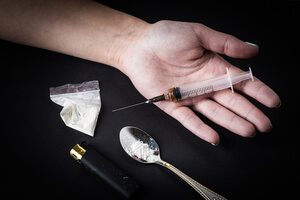Author: Leah K. Walker, Ph.D., LMFT
 Drug use—and the behaviors that sometimes accompany it—can increase the risk of contracting HIV. In 2016, about 30,000 new cases of HIV were attributed to sexual contact, and around 2,000 people contracted HIV from injecting drugs.1
Drug use—and the behaviors that sometimes accompany it—can increase the risk of contracting HIV. In 2016, about 30,000 new cases of HIV were attributed to sexual contact, and around 2,000 people contracted HIV from injecting drugs.1
Sharing needles, syringes, or other drug equipment can expose people to HIV.2 However, certain types of substance use are also linked to risky sexual behavior, such as having impulsive sexual encounters or not using condoms—which can also increase the risk of exposure to HIV and other sexually transmitted diseases.3
People who are both HIV positive and overcoming addiction can manage both conditions with an antiretroviral regimen and rehabilitation (medication and therapy). They may also lower the risk of transmission or re-infection. However, even people who continue to use drugs can prevent transmission by following safer practices when they inject drugs or have sex.
What Is HIV/AIDS?
HIV stands for human immunodeficiency virus. The virus attacks the body’s immune system, destroying a key infection-fighting type of white blood cell known as a T cell. The destruction of these cells makes the body vulnerable to infections and disease.4
HIV is a progressive infection, with 3 stages:4
- Acute infection, which occurs shortly after exposure to HIV. The level of the virus in the body, known as viral load, is high, and the person is very contagious. Often, people do not know that they are infected. But they may have a flu-like illness about 2 to 4 weeks after exposure.
- Clinical latency, which is the next stage of HIV. The virus is still active in the person’s body, but it replicates at low levels. People may not have any symptoms during this period. This phase can last a decade or longer, but may be shorter for some. If a person takes medication, their viral load may be so low that the risk of transmitting the disease to others is small. People who take medication may be at this stage for decades.
- AIDS, which is full-blown acquired immunodeficiency syndrome. At this stage, the body cannot fight infection effectively. Various infections attack the body, and eventually the person dies. This stage of the disease typically lasts about 3 years in untreated individuals. A person may experience swollen lymph nodes, fevers, chills, night sweats, and weight loss.
How Can It Spread?
 HIV is spread when a person has contact with blood or other bodily fluids infected with HIV.2 Sexual contact is the most common route of HIV transmission. Needle drug use results in thousands of additional HIV infections every year. When a person injects drugs with a needle used by someone who has HIV, there is a serious risk of being infected. In addition, even if needles are not shared, blood can be present in the water or cotton used to filter and inject drugs.3
HIV is spread when a person has contact with blood or other bodily fluids infected with HIV.2 Sexual contact is the most common route of HIV transmission. Needle drug use results in thousands of additional HIV infections every year. When a person injects drugs with a needle used by someone who has HIV, there is a serious risk of being infected. In addition, even if needles are not shared, blood can be present in the water or cotton used to filter and inject drugs.3
However, injecting drugs is not the only way drug use can increase the risk of contracting HIV. When a person is high, they may be more likely to have unprotected sex or have sex with someone they do not know. In some situations, a person may have sex to obtain drugs or get money for drugs and, in doing so, may be exposed to the HIV virus.
Some drugs have been associated with risky sexual behavior and/or a heightened risk for contracting AIDS/HIV, including:3
- Alcohol, which can decrease inhibitions and lead to risky and/or unprotected sex.
- Opioids, which are frequently injected and can cause an increased risk of HIV transmission. The compulsive nature of opioid addiction may also compel users to trade sex and/or money for drugs.
- Meth, or methamphetamine, which is associated with high-risk sexual behaviors, including having multiple partners and not using a condom. In addition, meth is often injected.
- Crack cocaine, which can cause users to spend all of their money on the drug and turn to trading sex for drugs, increasing their risk of exposure to HIV.
- Inhalants such as “poppers,” which is another drug associated with risky sexual behaviors, illegal drug use, and sexual transmitted diseases, particularly among gay and bisexual men.
HIV Rates From Drug Use
The risk of HIV transmission varies based on the type of activity. But even low-risk activities, repeated over and over, can increase the risk of HIV transmission over time.5
According to the Centers for Disease Control (CDC), for every 10,000 exposures, the risks of acquiring HIV from an infected source are the following:5
- Receptive anal intercourse – 138.
- Needle-sharing during injection drug use – 63.
- Percutaneous (needle stick) – 23.
- Insertive anal intercourse – 11.
- Receptive penile-vaginal intercourse – 8.
- Insertive penile-vaginal intercourse – 4.
The CDC notes that HIV diagnoses for people who inject drugs have decreased over the past several years. However, they have decreased more among certain ethnic groups than others.6
- About 10% of new HIV diagnoses are among people who inject drugs.
- Overall, annual diagnoses among people who inject drugs decreased by 48% between 2008-2014.
- Diagnoses decreased by about half among blacks and Hispanics who inject drugs.
- Annual diagnoses dropped by 28% for urban white injection drug users between 2008 and 2012, but they did not drop between 2012 and 2014.
The CDC also reports that fewer blacks and Hispanics are sharing needles and syringes. Whites are more likely to share them, and they are also more likely to start injecting at younger ages.6
Importance of Seeking Treatment
HAART prevents the virus from replicating and can slow down the progression of the disease.
The standard of medical treatment for HIV is known as highly active antiretroviral therapy, or HAART. HAART is a combination of 3 or more drugs customized to a person’s specific symptoms, strain of the virus, and viral load. HAART makes HIV a manageable condition, if the medications are taken as prescribed. HAART cannot cure HIV, and a person cannot stop taking the drugs without experiencing a progression of the disease.7
HAART prevents the virus from replicating and can slow down the progression of the disease.7 It can also prevent a mother from transmitting HIV to her unborn child and help lessen the risk of transmitting HIV to others.8
As with most medications, HAART has side effects, which can include:9
- Nausea.
- Fever.
- Vomiting.
- Diarrhea.
- Headache.
- Muscle pain.
- Dizziness.
- Insomnia.
Over time, more serious side effects can occur, including:9
- Kidney problems.
- Increase in fat levels in the blood (hyperlipidemia).
- Weakening of the bones.
- Diabetes.
- Heart disease.
- Liver damage.
- Nerve damage.
- Depression.
People with HIV who are also intravenous drug users may not receive HAART as often as people who don’t inject drugs, perhaps due to the belief that the person’s use of drugs makes treatment less effective. However, findings from recent studies indicate that intravenous drug users who receive HAART have similar outcomes in terms of life expectancy to HIV-positive people who don’t inject drugs.10
Further, when intravenous drug users receive treatment for opioid addiction with opioid replacement drugs such as buprenorphine or methadone, they are more likely to follow through with HAART. In general, buprenorphine is the treatment of choice in people with opioid dependency who are also HIV positive because it is less likely to interact with drugs that treat HIV.10
Taking Preventative Steps
Prevention is still the best tool to fight HIV. Some ways you can protect yourself from exposure to HIV include the following:3
- Get tested for HIV routinely (at least once a year).
- Don’t have sex when you’re high.
- When you do have sex, use a condom.
- Get immediate medical attention if you think you’ve been exposed to HIV. Drugs given for post-exposure may prevent infection if given within 72 hours of exposure.
- Take pre-exposure prophylaxis (PrEP), which are pre-exposure drugs to prevent getting HIV.
- Use new, sterile needles each time you inject. Find community programs that provide you with clean needles.
- Don’t share needles if you continue to inject drugs.
- Use sterile water to prepare drugs if you use IV drugs, and clean your skin with an alcohol swab before you inject.
- Clean your needles with bleach if you can’t get new ones.
Syringe services programs (SSP) can also help reduce the spread of HIV. These programs provide sterile syringes to people who inject drugs, referrals to treatment, access to HIV testing and treatment, and information on treating drug overdoses. Around half of all intravenous drug users received some form of service from an SSP in 2015. However, only about a fourth of intravenous drug users received all of their syringes from an SSP.6
What Challenges Are Presented?
There are several challenges to HIV prevention and treatment in the intravenous drug user community. Barriers to effective prevention include the following:11
- People who use drugs often face multiple issues, such as homelessness, poverty, and unemployment, all of which make it harder to access HIV prevention resources.
- Many people who are intravenous drug users feel stigmatized and ashamed. They might be fearful of arrest and, therefore, may not seek treatment for substance abuse.
- People who use drugs may not seek HIV testing because they don’t want to answer questions about their use of substances.
- People who use substances may be less likely to adhere to HAART treatment due to certain side effects from the interaction of the drugs and HIV medications.
The most effective approach to HIV prevention appears to be a multi-tiered approach, where the medical community, social services, and law enforcement work together to provide education, testing, and interventions such as clean syringes and treatment for both HIV and drug abuse.
If you or someone you know uses drugs and is at risk of HIV, considering getting help through a drug rehab center. If you aren’t comfortable entering rehab, take steps to minimize your risk of HIV infection (e.g., syringe services programs), get tested regularly, and find treatment help if needed.
Sources
-
1. Centers for Disease Control and Prevention. (2016). HIV surveillance report.
2. National Institute on Drug Abuse (2018). What’s the relationship between drug use and viral infections?
3. HIV.gov. Substance use and HIV risk.
4. Centers for Disease Control and Prevention. (2018). About HIV/AIDS.
5. Centers for Disease Control and Prevention. (2015). HIV risk behaviors.
6. Centers for Disease Control and Prevention. (2016). HIV and injection drug use.
7. National Institute on Drug Abuse. (2012). What is HAART?
8. National Cancer Institute. NCI dictionary of terms.
9. U.S. Department of Health and Human Services. (2018). Side effects of HIV medicines.
10. National Institute on Drug Abuse. (2012). Can HIV be prevented and treated in drug using populations?
11. Centers for Disease Control and Prevention. (2018). HIV and substance use in the United States.
